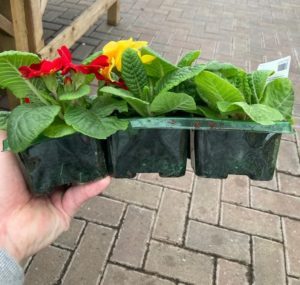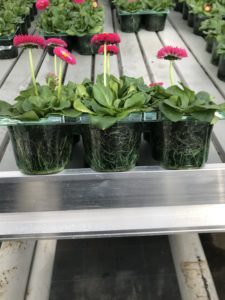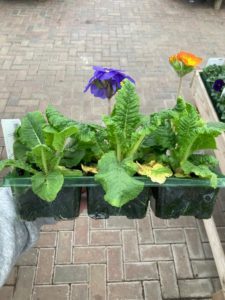In this article Horticultural Technical Manager, Joe Barfoot, looks at building plant foundations, utilising integrated crop management programmes without breaking the budget.
On recent nursery and garden centre visits around the UK, our team have seen situations where 'penny pinching' and at the other end of the spectrum playing catch up 'throwing the kitchen sink' at crops, has been producing some very poor performing plants. Building plant foundations, doesn't have to mean excessive spending, but it does mean not cutting corners, and growers should be considering an Integrated Crop Management (ICM) system throughout their production. A plant supplied with the correct level of nutrition along with correctly timed biostimulant throughout it's life cycle, is much more likely to thrive and produce high quality yields needed to meet specifications.
 The poor root structure in the first image shows the plant hasn't been able to set down the foundations it needs to provide for itself later in it's life cycle when water, energy and nutrient demand are crucial for sustained growth, which ultimately sets up the plant to suffer from abiotic stress. It's understandable that due to rising input costs growers are conscious of what they're applying to crops, more than ever, but a well designed ICM programme can be mapped out to boost nutrient efficiency without over applying nutrition and keeping costs under control.
The poor root structure in the first image shows the plant hasn't been able to set down the foundations it needs to provide for itself later in it's life cycle when water, energy and nutrient demand are crucial for sustained growth, which ultimately sets up the plant to suffer from abiotic stress. It's understandable that due to rising input costs growers are conscious of what they're applying to crops, more than ever, but a well designed ICM programme can be mapped out to boost nutrient efficiency without over applying nutrition and keeping costs under control.

 The crop in the first picture is unable to reach it's yield potential, with a poor root structure any future nutrition or agchem applied to it will become under utilised meaning the pot sits wetter leading to potential root death and risk of root disease, all becoming incredibly costly to the grower who's unable to present a plant that meets specification. Whereas the plant in the second picture is displaying a bold, colourful foliage. It's followed a robust nutritional programme designed to set the foundations and build upon them a healthy vigorous plant, less susceptible to pest and disease.
The crop in the first picture is unable to reach it's yield potential, with a poor root structure any future nutrition or agchem applied to it will become under utilised meaning the pot sits wetter leading to potential root death and risk of root disease, all becoming incredibly costly to the grower who's unable to present a plant that meets specification. Whereas the plant in the second picture is displaying a bold, colourful foliage. It's followed a robust nutritional programme designed to set the foundations and build upon them a healthy vigorous plant, less susceptible to pest and disease.

It all starts with the roots
One of the most important aspects of growing plants, is the roots. Without a strong root structure, no matter how much product you throw at it afterwards, it's not going to achieve that quality finish that's required. Look at these two plants below, in the first picture we see a plant with a particularly poor root structure. It's leaves are pale and there appears to be an element of disease creeping in, with poor leaf size and structure. Whereas in the second picture, the plants had received a carefully planned out ICM system including Kelpak and O-Phyte for rooting, then fed O-Mix 15-5-30, delivering a well established rooting system and beautiful hardy plant. The poor root structure in the first image shows the plant hasn't been able to set down the foundations it needs to provide for itself later in it's life cycle when water, energy and nutrient demand are crucial for sustained growth, which ultimately sets up the plant to suffer from abiotic stress. It's understandable that due to rising input costs growers are conscious of what they're applying to crops, more than ever, but a well designed ICM programme can be mapped out to boost nutrient efficiency without over applying nutrition and keeping costs under control.
The poor root structure in the first image shows the plant hasn't been able to set down the foundations it needs to provide for itself later in it's life cycle when water, energy and nutrient demand are crucial for sustained growth, which ultimately sets up the plant to suffer from abiotic stress. It's understandable that due to rising input costs growers are conscious of what they're applying to crops, more than ever, but a well designed ICM programme can be mapped out to boost nutrient efficiency without over applying nutrition and keeping costs under control.

Building plant foundations produce strong plant vigour
A plant that's been able to establish a strong foundation is capable of producing the high quality yield expected - a bold colourful plant able to withstand stresses. The two plants below demonstrate the difference between a crop that's utilised an ICM and a crop that's been under fed. The crop in the first picture is unable to reach it's yield potential, with a poor root structure any future nutrition or agchem applied to it will become under utilised meaning the pot sits wetter leading to potential root death and risk of root disease, all becoming incredibly costly to the grower who's unable to present a plant that meets specification. Whereas the plant in the second picture is displaying a bold, colourful foliage. It's followed a robust nutritional programme designed to set the foundations and build upon them a healthy vigorous plant, less susceptible to pest and disease.
The crop in the first picture is unable to reach it's yield potential, with a poor root structure any future nutrition or agchem applied to it will become under utilised meaning the pot sits wetter leading to potential root death and risk of root disease, all becoming incredibly costly to the grower who's unable to present a plant that meets specification. Whereas the plant in the second picture is displaying a bold, colourful foliage. It's followed a robust nutritional programme designed to set the foundations and build upon them a healthy vigorous plant, less susceptible to pest and disease.

